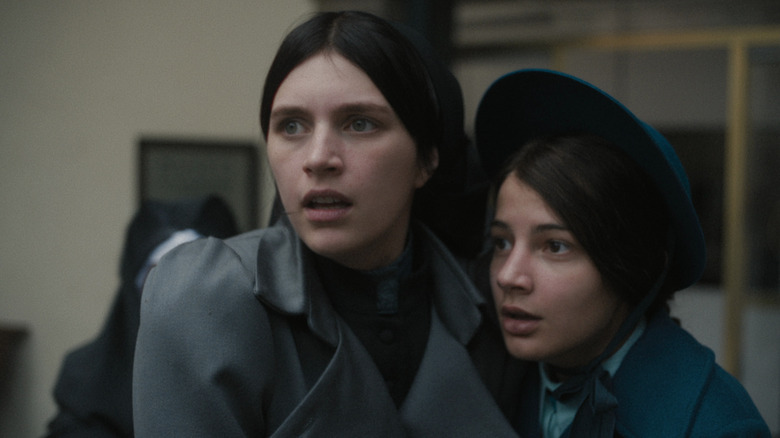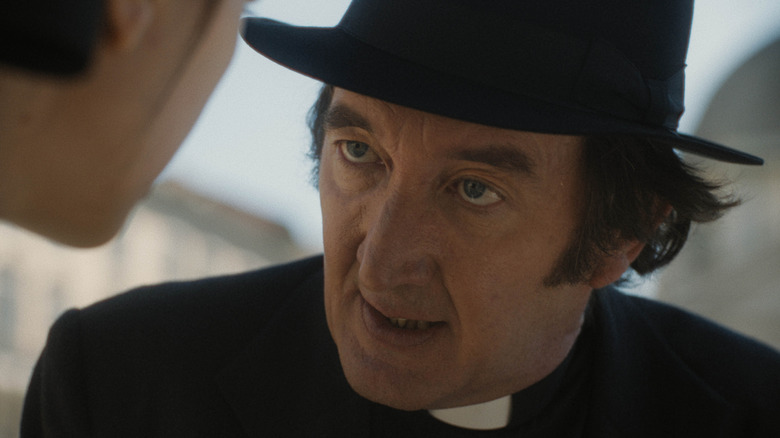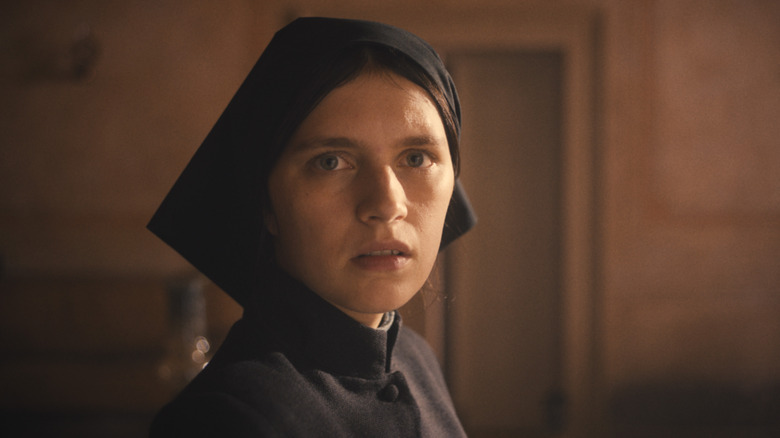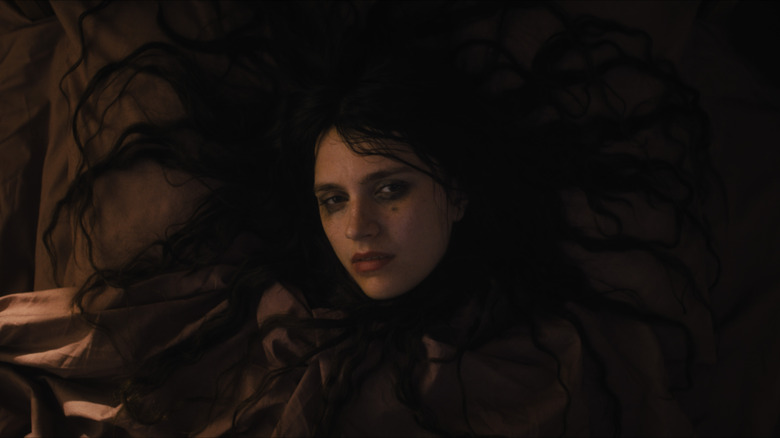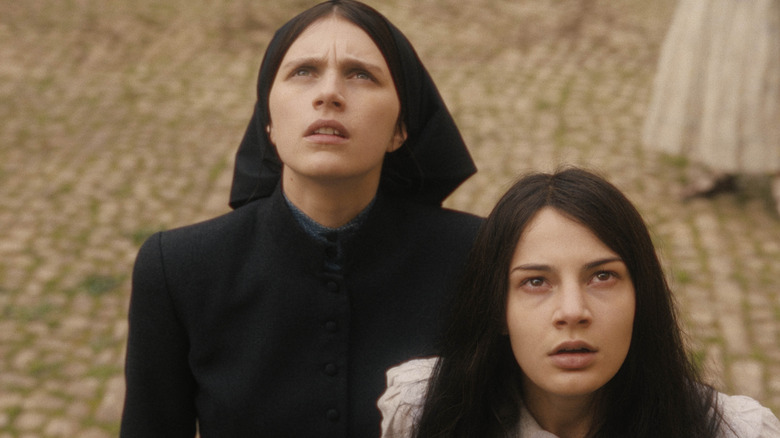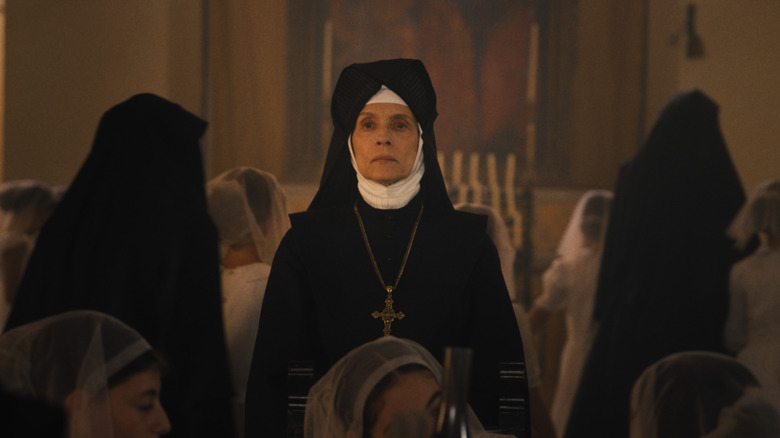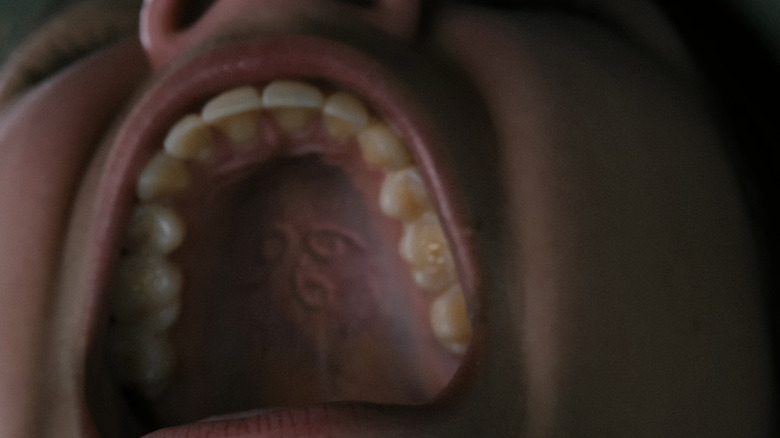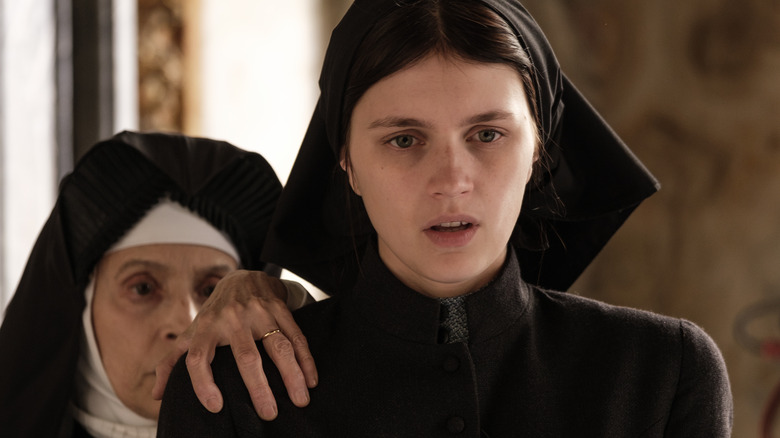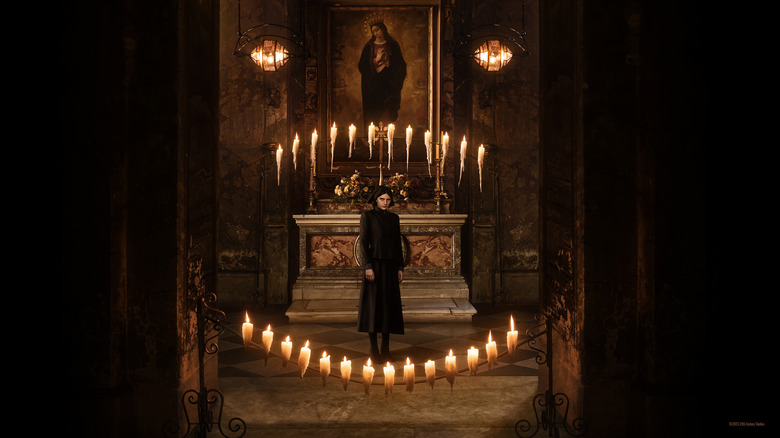The First Omen Ending Explained: Joining The Sisterhood
This article contains major spoilers for "The First Omen."
Hello folks! Welcome back to Nunsploitation 2024: Battle of the Babies.
When last we left the saga of Damien Thorn, it was 1981, and Damien was played by the devilishly handsome Sam Neill in "The Final Conflict." In that film, the Antichrist nearly fulfilled his evil purpose in halting the Second Coming of Jesus Christ, but was foiled by his one-time lover, journalist Kate Reynolds (Lisa Harrow), who through the grace of God and her own strength was able to fatally stab Damien with the magical dagger of Megiddo, the weapon that poor Robert Thorn (Gregory Peck) failed to use against his adopted son Damien (Harvey Spencer Stephens) when he was a child in 1976.
If a 33-year-old Damien in 1981 (or 1982, based on some conflicting dialogue in the movie) seems implausible given that the first film sees Damien as merely five years of age and the 1978 sequel, "Damien: Omen II" follows the exploits of a 12-year old Damien (Jonathan Scott-Taylor) in 1978, perhaps it's not merely the filmmakers missing the timeline forest for the trees in writing the sequels — perhaps there's something especially supernatural afoot. That quandary has been the major dramatic engine of the "Omen" films, a paradox of "this cannot be happening, and yet it is" that is part and parcel of the idea of the Antichrist coming to Earth in human form.
Given that Damien was apparently defeated in 1981, continuing the "Omen" saga has been its own quandary for 20th Century Studios née Fox; the campy 1991 made-for-TV sequel "Omen IV: The Awakening" saw Damien's offspring continue thanks to Satanic disciples meddling with genetics, 2006's remake of the original was far too uninspired and inert to establish a new start date for Doomsday, and the out-of-continuity 2016 A&E series "Damien" was cancelled before it could even make a (birth)mark.
Enter "The First Omen," a movie that's as inspired as it is terrifying, and which also acts as a highly intentional prequel to the original films. Though it necessarily takes place in the early 1970s, co-writer and director Arkasha Stevenson's film explores the evergreen ways in which the Church can abuse its congregation (especially children and women) and the power of faith in order to maintain influence and relevance in an increasingly secular world, a world where the lines between Good and Evil have become blurred.
A picture worth as few words as possible
"The First Omen" begins, appropriately enough, with an omen, as a familiar-looking priest approaches an ominous-looking church. Played by Patrick Troughton in the 1976 original, Father Brennan (Ralph Ineson) suspiciously eyes the scaffolding covering the under-renovation church, and with good reason: Brennan will eventually be killed in '76 by a metal pole that falls from the top of a church in London, shortly after he tries to warn Robert Thorn about the parentage of Damien.
For now, however, it is 1971, and the construction workers moving around various precarious heavy items bodes ill for someone else: Father Harris (Charles Dance), who has agreed to meet secretly with Brennan on the grave matter of another child. In the church's confessional, Harris hands Brennan a photograph of some priests and a nun holding a baby girl, with a name written on the back of the photo: Scianna. Brennan asks for more information, and Harris is too frightened to be very forthcoming. All he'll reveal is that the girl's mother was a devout woman, willingly giving herself to a secret group within the Church who made her fornicate with a jackal (which, as the original film revealed, is how Damien will eventually be conceived) and this baby is the result. Giving Brennan the name of the orphanage in Rome where the girl is currently being kept and watched over, Harris insists on ending the conversation and leaving as fast as possible.
Harris has good reason to be so worried, for as Brennan follows the priest outside, the construction workers slip, and a metal pole flies down toward Harris. Initially, Harris appears to be unscathed from the accident, yet, as he turns around, it seems the pole has split the back of his head wide open: a double warning for the doomed Father Brennan.
When in Rome
Margaret Daino (Nell Tiger Free) arrives in Rome, picked up at the airport by her friend Cardinal Lawrence (Bill Nighy), who used to be a priest at the orphanage Margaret grew up at back in Massachusetts. Margaret has come to Italy not only to become part of the staff at the Cardinal's new place of residence, the Vizzardeli Orphanage, but to take her own vows and finally become a nun within the Church. In both instances, Lawrence is heartened by Margaret's presence, for the fact that she is a young woman means that the Church may be able to use her to spread the gospel of Catholicism to a divided, generally secular generation, as evidenced by the wave of protests cropping up around the city.
After meeting the Abbess of the orphanage, Sister Silva (Sônia Braga), Margaret is told about the school's one problem child: Carlita Scianna (Nicole Sorace), a girl who is often kept away from the other children due to being reprimanded for various offenses. Margaret is instantly drawn to the girl, not just out of general sympathy but because of her own personal history. As it just so happens that Margaret was treated similarly as a child due to suffering from an overactive imagination that sometimes resulted in disturbing, even violent hallucinations.
Such outbursts led to abuse at the hands of some of the nuns who raised her, and thus Margaret, who has seemingly overcome her rough childhood to become a kind yet very shy woman, hopes to help Carlita avoid a similar fate. However, not all of Margaret's issues are far behind her, as her first night in her new apartment sees her hallucinations begin to start up again.
Dance with the devil
In very similar fashion to the protagonist of Dario Argento's "Suspiria," Margaret is assigned to be the roommate of the queen bee of prospective nuns at the orphanage, the young and beautiful Luz (Maria Caballero). Where Margaret is modest and reserved, Luz is vivacious, wearing very daring clothing on her nights out in Rome, justifying it by claiming that her body is about to become sacred once she takes her vows, so why not celebrate it beforehand?
That line of thinking is very seductive, so it's no surprise that Margaret is convinced by Luz to spend a night on the town with her in that spirit, the prospective nun dressing in highly revealing clothing and tagging along with Luz to a club. While there, Margaret meets a local man, Paolo (Andrea Arcangeli), with whom she strikes up a quick, breezy companionship. Enjoying the feeling of letting her hair down literally and figuratively, Margaret unknowingly speaks a phrase in Italian that hints at what's happening to her, a phrase taught to her by the kids at the orphanage which she thinks means "I'm a teacher, and I love to teach" but which actually translates as "I am a butterfly, and I must be allowed to fly." Taking this mantra to heart, the Italian Paolo brings Margaret out to the dance floor, where Margaret appears to become very friendly toward her date.
The next morning, a hungover Margaret wakes up, still dressed in her club clothes, with no memory of what happened the night before. Luz playfully explains that Margaret was getting very friendly with Paolo before she brought the girl home before she could do anything too sinful. Margaret is overall pleased with her taste of how the secular woman lives, yet there's an ominous feeling she can't shake, coupled with the fact that several insects seem to be taking a particular interest in her.
Ill omens
Turns out that ominous feeling doesn't dissipate after Margaret's wild night; it only grows stronger. Our favorite excommunicated paranoid priest, Father Brennan, turns up approaching Margaret with warnings about Carlita, claiming that "evil things are going to happen" around the girl very soon and that he must have the school's files on the girl in order to confirm her birthdate of June 6, stating that Carlita herself will bear the birthmark of 666 somewhere on her body. Not only does Margaret recoil from Brennan and his warnings, but they only add fuel to the fire of her wanting to help the girl, especially as the nuns keep sending Carlita to an isolation area that they've dubbed the Bad Room and Margaret is explicitly told not to speak with Carlita at all.
Following her heart instead of those warnings, Margaret corners Carlita while on a field trip to an art museum, telling the girl that maybe her outbursts and visions are all hallucinations like the ones she suffered as a child. Offended, Carlita runs off, and Margaret and the other nuns are able to secure her shortly before a riot breaks out in the streets, during which Margaret has a debilitating vision of something with a long, sticky tongue licking her face.
Margaret's visions only increase in frequency and intensity: during an incident where a young woman is giving birth within the orphanage's maternity ward, Margaret witnesses the attending nuns give the woman some drug which placates her, only to watch in terror as a demonic hand claws its way out of her vagina. Fainting, Margaret is revived by Cardinal Lawrence, who claims such fainting spells during births are very common.
Less common is the behavior of Sister Anjelica (Ishtar Currie-Wilson), a nun who seems to be actively encouraging Carlita's disturbing crayon drawings of girls in peril and pregnancy. When Margaret confronts Anjelica, the nun says nothing but gives Margaret a big kiss on the lips. Moments later, Sister Anjelica is on top of a ledge at the orphanage, stating "It's all for you" before setting herself on fire and throwing herself off the building, killing herself in a manner highly reminiscent of Damien's future nanny.
It's all a nunspiracy
In any other orphanage, such a horrific incident would be cause for an immediate investigation, but Sister Silva bizarrely sets her sights on Margaret, claiming that not only is the woman a bad influence and implying that it's due to a resurgence of her old mental illness, but that she will no longer be allowed to take her vows.
Her faith and sanity beginning to be shaken, Margaret encounters Paolo by chance on the street, yet becomes suspicious when he refuses to acknowledge or speak to her. Chasing after him and demanding answers, Paolo rants in Italian, pointing to his head before he's suddenly and violently run down by a passing truck. Pinned to a wall, Margaret tries to pull Paolo free, causing a fatal bisection in the process.
Sticking around the orphanage on a kind of probation, Margaret decides to search around for Carlita's files while Luz is being given her vows by the rest of the staff. Finding a secret door behind Sister Silva's desk (another nod to "Suspiria"), Margaret follows a path through dark corridors beneath the orphanage to a file cabinet which contains Carlita's file, along with that of numerous other girls, most of whom are dead. Horrified at this discovery, Margaret rushes back upstairs, grabbing Carlita and attempting to escape with her, only to be captured by the nuns and thrown into the Bad Room. While there, Margaret has another horrifying vision, that of a woman with her face torn off. She also finds a series of arcane, Satanic-looking illustrations on the floor of the room. Fortunately, she's rescued by Father Gabriel (Tawfeek Barhom), the man having grown unsettled by all the recent incidents and events. The duo escape the orphanage and abscond to Father Brennan's, as it turns out that Father Gabriel had also been solicited by Brennan for help earlier.
Coming to term(s)
At Brennan's, he, Margaret and Gabriel pore over the files Margaret swiped from the secret cabinet, confirming that an insidious sect within the Church have been planning and arranging the birth of the Antichrist for years now, in the hopes that such a horrendous event will hasten the final conflict and bring more people back to the Church (which, of course, would grant the Church that much more power and influence). Thus far, this sect has failed in their goals due to every offspring of the jackal and a woman being female, with the male Antichrist yet to be born.
Initially, Brennan supposes that Carlita is intended to be the mother of the hoped-for Antichrist, with her being sequestered by the nuns and others due to her reaching puberty. However, Margaret noticed earlier that Carlita's birthmark of 666 was inside the roof of her mouth; the picture given to Brennan by Father Harris shows the baby's birthmark being on her head. Realizing that this picture had been swiped from the file of another girl born from the jackal — not Carlita — Margaret remembers Paolo pointing to his head shortly before his demise, and worriedly has her own head examined. Sure enough, the birthmark of 666 is there beneath her hair.
At this revelation, Margaret begins to recall the events of her fateful night out, remembering how Paolo, at the behest of the sect, brought a drugged Margaret to the chamber where the jackal is kept, and Margaret (while being watched by the nuns in very "Rosemary's Baby" fashion) was then impregnated by the beast before being returned to her apartment. Realizing that it's almost 6 a.m. on the day of June 6, Brennan convinces Margaret to flee with him and Gabriel out of the city with the files as proof of the Church's plot, even as Margaret protests, worried about Carlita's fate.
Unfortunately, the forces of darkness are insistent that the Antichrist be born, as a vehicle rams into Margaret's car. With Gabriel dead and Brennan unconscious, Margaret attempts to flee, but is stopped cold by the unholy pregnancy inside of her beginning to rapidly accelerate, causing a physical transformation that homages such films as "Possession," "Warlock: The Armageddon," and "Species II." (This accelerated development could hint as to how Damien, in the later films, grows up so damned fast.)
Bloody birthday
Now recaptured by the sect and brought back to their Satanic chamber beneath the city, Margaret helplessly watches as Cardinal Lawrence explains the feeble justification for the Church's plans while she's injected with the same incapacitating drug she saw used on the pregnant woman earlier in the film. In the film's most insidiously chilling scene, Margaret pleads for help while the congregation of Satanists — all of whom would likely claim that they're devout Catholics, dedicated to the good of humanity — look on silently, unmoved.
The attending nuns force Margaret to have a C-section birth, removing a ghastly-looking sac from her womb and slicing it open. Surprisingly, Margaret has given birth to twins, and while news of another girl child is received with little interest, the news of a boy child gives way to rapturous rejoicing by the nuns and priests. Begging Cardinal Lawrence to be allowed to hold her baby, the man acquiesces, only for Margaret to stab the Cardinal and hold the baby hostage in order to try and escape. Contemplating killing the Antichrist right then and there, Margaret is foiled by none other than her former confidant and roommate, Luz, who is now part of the sect. Stabbed and bleeding, Margaret is left for dead as the sect remove the boy and leave Margaret, the newly born girl, and even the jackal to be burned alive.
Before Margaret and her daughter can be roasted, however, Carlita is able to break into the chamber, helping rescue her "sister (and sisterniece)" while their "father," the beast, dies in flames.
The boy with a Thorn on his side
The sect go about their unholy business, arranging for the newly born Antichrist to be placed in the most proper family possible. Sure enough, they choose the American diplomat Robert Thorn, currently living in Rome, to be the father. As Luz, Sister Celia and the others appear pleased with themselves and their quest, it's important to recall that Thorn's real baby, born the same morning to his wife, Katherine (played in this film by Rachel Hurd-Wood), isn't merely sent off somewhere — in "The Omen," Robert later finds the grave where his real child lies, the baby's head clearly having been caved in.
Despite being literal children of the beast, Margaret, her daughter, and Carlita are far more nurturing and loving than the members of the Church, at whose hands they've all suffered some form of abuse. The three women are revealed to now reside with each other at a remote cabin in the snowy woods, hoping to live their lives in peace having formed their own special sisterhood. Father Brennan, who survived the earlier car crash, tracks them down, presumably wondering about their fate. As Margaret holds Brennan off with a shotgun, demanding she and her new family be left alone, Brennan reveals that he's arrived to deliver some information to them, too. "They've even given it a name, your son: Damien," he says, ominously.
Although we know exactly where the saga of the Antichrist known as Damien Thorn takes him from here, it's not clear whether this is the last we'll see of Margaret, Carlita, or Damien's mysterious twin sister. Is this baby someone we've seen before, perhaps even (incest be damned) Damien's eventual killer, Kate Reynolds? Is this baby girl someone else, maybe a figure who could stand up to Damien's offspring post-"Omen IV?" Does Brennan intend for Margaret to join him in his quest to stop the Antichrist, and if so, will she?
Only time will tell. However, as we all inherently feel, we may not have much time left. As the original ads for "The Omen" stated, with each passing day we're one day closer to the end of the world, especially if those in power — be it the Church, CEOs, billionaires, etc. — remain able to dictate our fate. Whatever will be, we can't say in hindsight that we weren't warned.
